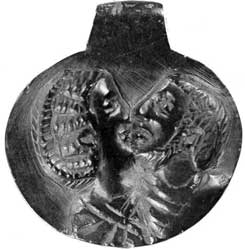
Click on the image for a larger version.
|
Image
details:
The jet medallion represents a betrothed
couple. Although the medallion, found in the vicus, is of
a later date (late 3rd century AD), it reminds us that families
as well as soldiers lived at Vindolanda
Image ownership:
© Vindolanda Trust |
From most Roman sites in Britain we know the names of only a handful
of individuals, from inscriptions on stone or graffiti. In the Vindolanda
tablets, by contrast, we meet over 200 named individuals, the writers
and recipients of letters as well as individuals referred to in
accounts and lists. The tablets sometimes contain further information
on particular individuals, most often their rank, but also sometimes
their place of origin and their connections of kinship or friendship.
Occasionally individuals are attested in the Vindolanda tablets
who are also referred to by Roman historians or on inscriptions.
For example a draft letter from Flavius Cerialis refers to the governor,
Marcellus (225). This is Neratius Marcellus,
governor of Britain in AD 103, a powerful figure glimpsed in one
of the letters of the Roman author Pliny, exercising his patronage
to obtain an officer's position for Suetonius, the biographer of
early Roman emperors. At a less elevated social level Veldedeius,
the governor's groom, is named in a tablet (310)
and on a leather offcut found at the site. The offcut was produced
in making a horse chamfron, which a groom might plausibly order.
A Vilidedius commemorated on a tombstone, possibly found at the
nearby fort of Housesteads, may be the same man.
This part of the exhibition introduces the units stationed at Vindolanda
and their origins, as well as some of the individuals whom the tablets
reveal to us. The archaeological finds, especially footwear and
dress accessories extend our understanding of the Vindolanda community.
In particular they remind us of the presence of women and children
in camp. We depend almost entirely on archaeology for our knowledge
of the 'silent majority' of the frontier area, the native population.
Further relevant information is also contained in the reference
section under names.
Tablet database link: Browse the tablets by the names of people mentioned.
|